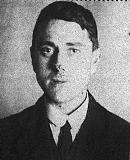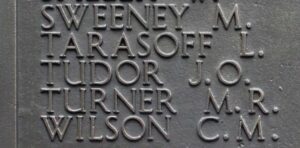St. Davids is situated in a beautiful position on the Pembrokeshire coast, and has the honour of being the smallest City in Britain. Originally known as Mynyw, the City was founded by St. David around AD550, and became a popular Pilgrim destination during the Medieval period, after Pope Calixtus II decreed that two Pilgrimages to St. David’s would equal one to Rome itself. Today the City is a popular tourist destination, and is home to the ancient Cathedral dedicated to St. David, as well as the famous Bishop’s Palace. The men of the Parish of St. David’s who fell during both World Wars are commemorated on two wooden plaques within the Cathedral, and also by identically named plaques which are located in the City Hall. There are also several other memorials inside the Cathedral, which are documented elsewhere on the website. Many thanks to Richard Parr for locating and photographing the War Memorials.
The Great War, 1914-1918
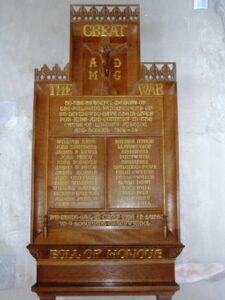
Richard Stanley Barkway, Private, 30802, East Yorkshire Regiment. Richard was the son of Richard and Kate Ellen Barkway, and had been born at Hinchley. The family resided at the Grove Hotel, St. David’s prior to moving to 53, Robinson Street, Llanelli prior to the war. Richard then enlisted at Carmarthen into the army sometime in 1917, and was posted to France to join the 1/4th Battalion, East Yorkshire Regiment, which was attached to 150 Brigade, 50th (Northumbrian) Division. The Division had fought at Second Ypres in 1915, and on the Somme in 1916. In 1917 it had fought at the Battle of Arras, and then at Passchendaele later that year. It remained at Ypres for the winter, before moving to St. Quentin, where it was hard hit by the German Spring Offensive of 21 March 1918, during the Battle of St Quentin. They took part in a gallant rearguard action during the Actions at the Somme Crossings, and then at the Battle of Rosieres. After suffering terrible casualties, the Division moved north to Flanders to rest and rebuild, but in April the Germans launched an attack in Flanders, around the Lys, and the Division took part in the Battle of Estaires, and it was here that Richard was mortally wounded. He died of his wounds aged just 18, on 21 April 1918, and is buried at Aire Communal Cemetery, France, in Grave II. E. 13.
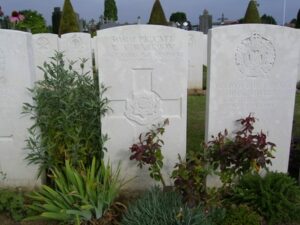
Francis (Frank) Byrant, Private, 61692, Welsh Regiment. Frank was the son of William and Mary Ann Byrant, of Quickwell, St. Davids. He enlisted at Haverfordwest on 15 April 1915 into the Army Service Corps. He had served in France for three months with the ASC before being posted to Egypt, and was posted to the 24th Battalion, Welsh Regiment. The Battalion had formed in Egypt in March 1917 by merging the Pembroke and Glamorgan Yeomanry Battalions, and joined 231 Brigade, 74th (Yeomanry) Division. The Division then took part in the advance into Palestine, where it fought at the Second and Third Battles of Gaza, and in the capture of Jerusalem. In May 1918 the Division was moved via Marseilles to France, where it took up positions on the Lys. After a tough baptism into trench warfare, the Division then moved to the Somme, where it took part in the Battle of Épehy, where the 24th Welsh launched an attack against the strongpoint of Gillemont Farm, on the Hindenburg Outpost defences. Frank was one of many men to be killed among the ranks of the 24th Welsh at Épehy. He was killed on 21 September 1918, aged 21. Frank was originally reported to have been buried by the 3rd Australian Division Burials Officer, but his grave was lost during further fighting, and he is today commemorated on Panel 7 of the Vis-En-Artois Memorial, France.
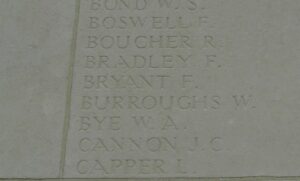
John Griffiths, Lance Corporal, 26088, Welsh Regiment. John was the son of Thomas and Catherine Griffiths, of Rhostywarch, St. Davids. He enlisted at Bridgend into the Welsh regiment. After training, he was posted to the 17th Battalion, Welsh Regiment, which was attached to 119 Brigade, 40th (Bantam) Division. The Division moved to France between the 1st and 9th June, and moved to the front near Loos. Late in 1916 they moved south to the Somme, and fought at the Battle of the Ancre, and remained in the area over the winter. In March, 1917 the Germans withdrew to their shortened line, called the Hindenburg Line, and the 40th Division were one of the Divisions that followed the withdrawal. John was killed during this stage of the war, on 24 April 1917, aged 20. He is buried at Fifteen Ravine British Cemetery, Villers-Plouich, France.
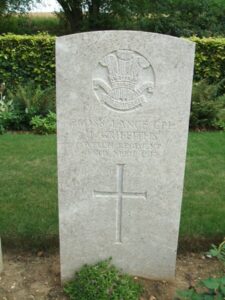
Oliver Eynon Griffiths, Private, 32759, Welsh Regiment. Oliver was born in St. Davids in 1895, the son of Ebenezer and Margaret Griffiths. By 1911 the family had moved to 5, Dyfodwg Street, Treorchy where Oliver begun work as a collier. He enlisted at Pentre into the 19th Battalion, Welsh Regiment early in 1915, before marrying Ethel John, and then trained with the battalion at Rhyl and Winchester before it moved to France as the Pioneer Battalion to the 38th (Welsh) Division on 4 December 1915. The division was initiated into trench warfare in the Fleurbaix sector and held various parts of the line from there to Givenchy before being moved to the Somme sector in June 1916, where it took part in the assault and capture of Mametz Wood. After its withdrawal from the Somme the division trained in Northern France before being sent to the Boesinghe sector, north of Ypres and held the line along the canal bank. Oliver was one of two men killed and another wounded while the battalion was at work around Welsh Farm on 14 October 1916. The 21 year old is buried in Essex Farm Cemetery, Belgium. He does not appear to be commemorated locally.
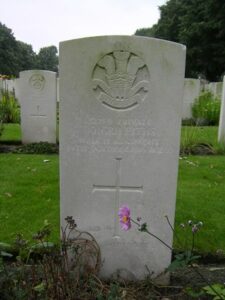
William James Harries, Stoker 2nd Class, K/31623, Royal Navy. William was born on 4 October 1893, the son of Elias and Dinah Harries, of Penrhiw Farm, Goodwick. He served in the Royal Navy aboard H.M.S. Q1 (Perugia). Perugia was a Q-Ship, which operated as an undercover merchant vessel with hidden guns, and was intended to be used to lure German submarines to their fate. On 3 December 1916, Perugia was off the north-west coast of Italy, in the Gulf of Genoa, when she was torpedoed and sunk by the German submarine U-63. William was 23 years old when he died that day, and is commemorated on Panel 16 of the Plymouth Naval Memorial, Devon. (The photograph of William is courtesy of Chris John).
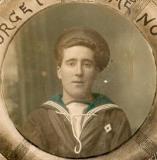
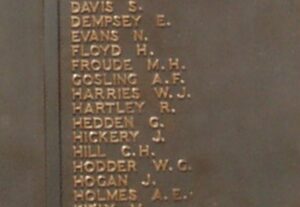
William Hart, Private, 38168, Welsh Regiment. William was the son of Joseph and Eliza Hart, of 45, Hoy Street, Canning Town, London, and lived at Hendre Eynon, St. Davids prior to the war. He enlisted into the 9th Battalion, Welsh Regiment, which moved to France in July 1915 attached to 58 Brigade, 19th (Western) Division. The Division moved to positions near Festubert, north of Loos, where it readied to take art in the forthcoming Battle of Loos. William was killed here on 22 September 1915, while the 9th Welsh were getting ready for a move to Loos. He was 19 years old, and is buried at Brown’s Road Military Cemetery, Festubert, France.
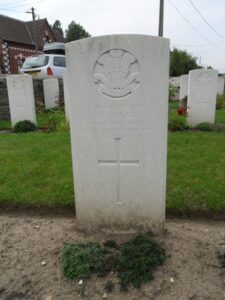
Harold Keith De Warenne Harvey, Lance Corporal, 84, Australian Imperial Force. Harold was born at Letterston in 1895, the son of Joshua Harold Harvey, and Emily Jane Harvey (nee Harries), and the Grandson of George Harries of Trevacoon, St. David’s. The family later resided at Marrick, Totland Bay, Isle of Wight. Harold had emigrated to Australia prior to the war, where he sought his fortune as a pearl fisherman, and enlisted at Broome, Western Australia, on 5 February 1915 into the Australian Imperial Force. Harold joined the 28th Battalion, AIF, which was attached to the 7th Australian Brigade, 2nd Australian Division. Harold then embarked at Fremantle on 12 July 1915 aboard the HMAT Ascanius, and sailed to Egypt, landing at Gallipoli on 4 September 1915. He was then attached to a Machine Gun unit at Gallipoli, and remained there until being evacuated in January 1916. On 21 March 1916 Harold landed at Marseilles, now back with the 28th Battalion, and they entrained for Northern France, taking the line near Bois Grenier. Harold was killed in action here during a routine spell in the trenches on 25 April 1916. He was 22 years old, and was buried at Ration Farm Military Cemetery, France. His younger brother Ralph De Warenne Harvey also fell. Harold is not commemorated at St. David’s or Letterston.
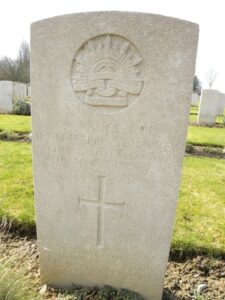
Ralph De Warenne Harvey, Second Lieutenant, Kings Royal Rifle Corps. Ralph was born at Letterston in 1898, the son of Joshua Harold Harvey, and Emily Jane Harvey (nee Harries), and the Grandson of George Harries of Trevacoon, St. David’s. The family later resided at Marrick, Totland Bay, Isle of Wight. Ralph was educated at Weymouth College, where he excelled at cricket, and was commissioned in January 1915 into the Dorsetshire Regiment. He was then posted to the 1st Battalion, King’s Royal Rifle Corps, which was in France attached to 99 Brigade, 2nd Division. The Division had been in France since the outbreak of war. In 1915 they took part in the Battle of Festubert, and in September fought at the Battle of Loos, and subsequent Action of Hohenzollern Redoubt. Ralph was seriously wounded at Loos, just as the Battalion was beginning its preparations for the move to the Somme, and died of his wounds on 7 June 1916, aged just 18. He is buried at St. Sever Cemetery, Rouen, France. His elder brother Harold Keith De Warenne Harvey also fell. Ralph, like his brother, is not commemorated at St. David’s or Letterston.
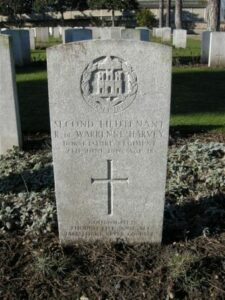
William Howells, Private, 29202, South Wales Borderers. Willie was the son of Benjamin and Mary Howells, of Waunbeddau, St. David’s. Willie enlisted on 8 December 1915 into the South Wales Borderers, but was placed on the reserve until being mobilised in January 1917. He was a ploughman, and was transferred to the 421st Agricultural Company, Labour Corps, at Warrington, before being posted to the 533rd Agricultural Company at Carmarthen. Willie never served overseas, and died of pneumonia at Waunbeddau on 26 November 1918, aged 23. He is buried at St. David’s (Berea) Congregational Chapelyard. Willie is not commemorated at St. David’s, but at nearby Croesgoch.
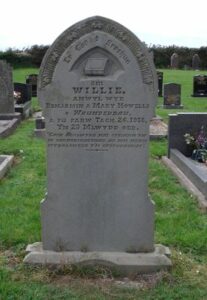
Albert Bowen Marsh Jenkins, Private, 47355, Bedfordshire Regiment. Albert was born at St. Davids in 1896, the son of David Bowen Jenkins and Delilah Jenkins. The family later moved to 2, Copper Street, Roath, Cardiff. Albert enlisted at Cardiff into the Royal Army Medical Corps, but was later posted to the 5th Battalion, Bedfordshire Regiment, which was attached to 162 Brigade, 54th (East Anglian) Division. In July 1915 the division embarked at Liverpool, for Mudros Island, and on 10 August 1915 was landed at Suvla Bay, Gallipoli. Here it remained until being evacuated in December 1915, when the entire 54th Division was withdrawn from Gallipoli, and moved to Egypt, and eventually into Palestine in early 1917. Here it fought in the successful campaign to drive the Turks from Palestine, and was present at the capture of Jerusalem. Albert was taken ill during the end of 1917, and returned to Britain for treatment. He died in hospital at Brighton on 6 March 1918, aged 21, and is buried at Cardiff (Cathays) Cemetery. Albert is not commemorated at St. David’s.
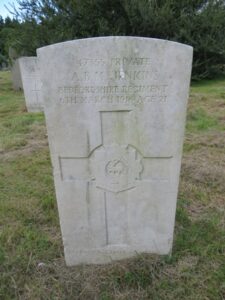
Edwin John, Stoker, K/35290, Royal Navy. Edwin was born on 18 February 1898, the son of Henry and Caroline John, of St. Brides View, St. David’s. He had served during the war with the Royal Navy, aboard H.M.S. Liverpool, which was a Town Class Light Cruiser, which had served during the duration of the war, before sailing to Archangel after the Armistice, to aid the White Russians during the Russian Revolution. Edwin became ill before she sailed to Russia, and died on 7 March 1919, aged 21. He is buried at St. Davids Parish Cemetery. Edwin is not commemorated at St. David’s.
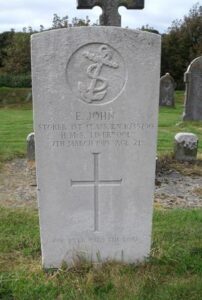
George William Land, Carpenter’s Mate, Mercantile Marine. George was from Chatwell, Staffordshire, and served aboard S.S. Mesaba, a small passenger ship which had been built by Harland and Wolff, in Belfast in 1897. Mesaba had had become famous for sending a radio message to the Titanic, warning her of ice, but as is now known, the message was not received. She sailed for the Red Star Line between 1912 and 1914, before returning to Atlantic Transport Line service in June 1915. She was torpedoed by the German U-Boat U118 on 1 September 1918, and sank in St. George’s Channel, while making a convoy voyage from Liverpool to Philadelphia in ballast. Twenty of her crew were lost, including her commander. George’s body must have been washed ashore near St. David’s, as he is buried at St. David’s Parish Cemetery. George is not commemorated locally.
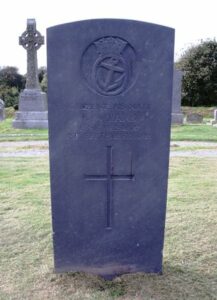
James Henry Lewis, Private, 23296, Kings Own Yorkshire Light Infantry. James had been born at Lower Treginnis, St. David’s. He resided with his grandparents Lewis and Hannah Lewis for several years prior to the war, and enlisted at Haverfordwest into the 12th Reserve Cavalry Regiment. He was later posted to join the 2nd Battalion, King’s Own Yorkshire Light Infantry, which was in France attached to 97 Brigade, 32nd Division, which landed there at the end of December, 1915. The following year the Division took part in the opening of the Somme Offensive, and it was during this first disastrous day, on 1 July 1916, that James became one of almost 20,000 men killed during the opening assault of the Battle of the Somme. James was 24 years old, and is commemorated on Pier and Face 11C and 12A of the Thiepval Memorial, France.
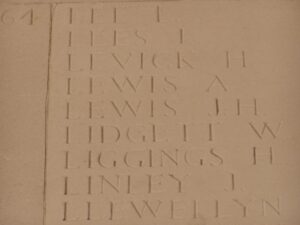
Mortimer Lewis, Private, 24492, Royal Welsh Fusiliers. Mortimer was born in 1876, the son of John and Emma Lewis, of Oakley Street, St Davids. He had worked at Aberdare as a Colliery Returner prior to the war, and enlisted there into the 8th Battalion, Royal Welsh Fusiliers. The Battalion formed part of 40 Brigade, 13th (Western) Division, and landed at Gallipoli in July 1915, where it saw heavy fighting over the coming months. On 8 January 1916, the Division was evacuated from Helles, and by 31 January was concentrated at Port Said, where they held forward posts in the Suez Canal defences. On 12 February, 1916 the Division began to move to Mesopotamia, to strengthen the force being assembled for the relief of the besieged garrison at Kut al Amara. By 27 March, the Division had assembled near Sheikh Saad and came under orders of the Tigris Corps, and then took part in the attempts to relieve Kut. Mortimer was killed during this move into Mesopotamia, on 5 April 1916. He was 40 years old, and is commemorated on Panel 15 of the Basra Memorial, Iraq.
Percival Price Morgan, Sapper, 51933, Royal Engineers. Percy was born in St. Davids in 1893, the son of Joseph Voyle Morgan and Jane Morgan. His father had gained a position as clerk of works for Miss Talbot at Margam Castle and by 1901 had moved the family to 27 Rice Street, Port Talbot. Percy was a trained surveyor prior to enlisting at Aberavon along with his best friend, Cyril Ogden, into the Royal Engineers on 10 September 1914 and was posted to Gallipoli with the 13th Signal Company, Royal Engineers in June 1915. The company was attached to the 13th (Western) Division and landed at Gallipoli on 6 July 1915, relieving the 29th Division. At the end of the month it was withdrawn to Mudros before being landed at ANZAC Cove from 3 August. The division saw heavy fighting at ANZAC before being transferred to Suvla Bay, where it remained until the evacuation on 13 December 1915. Percy was killed in action here when a Turkish shell burst, killing him and his friend Cyril Ogden on 27 November 1915, just two weeks prior to being evacuated. The 22 year old Percy has no known grave and is commemorated on the Helles Memorial, Gallipoli. He does not appear to be commemorated at St. Davids.
James Morris, Sapper, 108496, Royal Engineers. James was the son of Caleb and Anne Morris, of Gwrhyd Mill, St. Davids. He enlisted at Haverfordwest into the Royal Engineers on 9 August 1915. Within weeks, James was posted to their 156th Field Company, which moved to France as part of the 16th (Irish) Division in December 1915, and concentrated in the Bethune area. They saw their first major action during the Somme Offensive, at the Battle of Guillemont, and also fought at the Battle of Ginchy. The Division then moved to Messines, and it was soon after this move that James was killed on 29 November 1916. He was 24 years old, and is buried at Loker Churchyard, Belgium, in Grave I. D. 16. He is also commemorated on his parents gravestone at St. Davids.
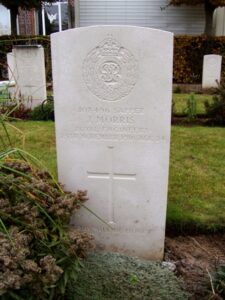
Albert William Prance, Private, 54587, Welsh Regiment. Albert was the son of Captain Henry Thomas Prance and Alice Maud Prance, of Penberry, Solva. He enlisted at Swansea into the Welsh Regiment, and after training was posted to France to join the 15th Battalion, Welsh Regiment, known as the Carmarthen Pals. The Battalion had formed in October 1915 at Rhyl, before moving to Winchester, where it joined 114 Brigade, 38th (Welsh) Division, and landed in France in December 1915, moving to positions in the line at Fleurbaix. The Division had captured Mametz Wood during the Battle of the Somme in July 1916, and the following year captured Pilckem Ridge during the opening stage of the Battle of Passchendaele. It then over-wintered near Armentieres, before being sent to reinforce the badly stretched British line on the Somme following the German offensive of Spring 1918, taking up positions in the Aveluy Wood sector. On 21 August 1918, elements of the 15th Welsh swam across the flooded River Ancre, and after capturing several German strong points, set up positions for the remainder of the Battalion to join them the following day. Over the coming days, the 15th Welsh captured the heights of Thiepval Ridge, and the village of Pozieres, before pushing on towards Delville Wood, as part of the great 100 days offensive which was to ultimately win the war. Albert was wounded during the launching of the offensive, and died of is wounds at a Casualty Clearing Station at Varennes on 7 September 1918. He was 21 years old, and is buried at Varennes Military Cemetery, France, in Grave IV. A. 63.
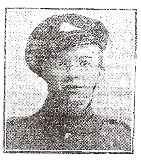
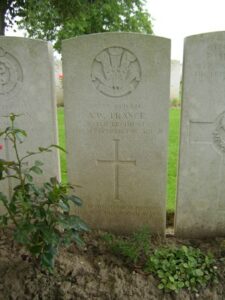
James Thomas Price, Private, 34124, South Lancashire Regiment. James was the son of William and Phoebe Price, of Treleddidfawr, St. David’s, and had enlisted at Rhyl into the newly formed 15th Battalion, Welsh Regiment, known as the Carmarthen Pals. After receiving its initial training at Rhyl, the 15th Welsh moved to Winchester, where it joined 114 Brigade, 38th (Welsh) Division, and landed in France on 4 December 1915, moving to positions at Fleurbaix. At some time after this, James must have been wounded, and after recovering was posted to the 8th Battalion, South Lancashire Regiment, which was attached to 75 Brigade, 25th Division. After successfully defending Vimy Ridge against a German attack in May 1916, the Division moved to the Warloy area of the Somme, and attacked on 3 July near Thiepval. They fought throughout the Battle of the Somme, and it was here that James was killed, aged 27, on 1 October 1915. He has no known grave, and is commemorated on Pier and Face 7A and 7B of the Thiepval Memorial, France.
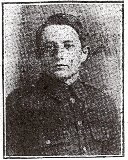
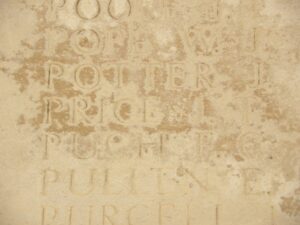
John Price, Private, 20911, York and Lancaster Regiment. John was the son of David and Ann Price, of Maenygroes, St. David’s. He enlisted at Haverfordwest in September 1914 into the Hussars, but was later posted to the 6th Battalion, York and Lancaster Regiment, which was attached to 32 Brigade, 11th (Northern) Division. On 1 July 1915 the Division sailed from Liverpool, landing at Alexandria, before moving on to Mudros, completing concentration by 28 July 1915. They landed at Suvla Bay, Gallipoli on 7 August 1915 and remained there until the evacuation on 21 December 1915, when they moved to Egypt. During July 1916 the Division landed at Marseilles, and then spent remainder of the war on the Western Front, fighting at the Battle of Flers-Courcelette during the Somme Offensive. It was here that John was killed on 27 September 1916. He was 21 years old, and is commemorated on Pier and Face 14A and 14B of the Thiepval Memorial, France.
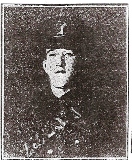
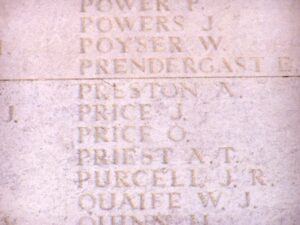
Robert Hugh Roberts, Gunner, 118426, Royal Field Artillery. Robert was the son of David and Mary Roberts, of Upper Treginnis Farm, St. David’s, and had enlisted at Haverfordwest into the Royal Artillery. He was posted to their 52nd Battery in France, and took part in the Battle of the Somme in the summer of 1916. Robert was wounded on the Somme, and died as a result on 9 September 1916, aged 24. He is buried at Bronfay Farm Military Cemetery, Bray Sur Somme, France, in Grave I. C. 32.
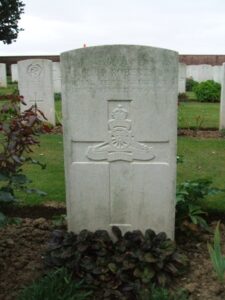
John Stephens, Gunner, W/2742, Royal Field Artillery. John was the son of Thomas and Elizabeth Stephens, of Llandruidion, Solva, and enlisted at Cardiff into the Royal Field Artillery. He was posted to the ‘Z’, 38th Trench Mortar Battery, which was attached to the 38th (Welsh) Division. The Division moved to France in December 1915, and took up positions near Fleurbaix. They remained in this sector over their first winter on the front, and it was here that John was killed on 16 May 1916. He is buried at Royal Irish Rifles Graveyard, Laventie, France.
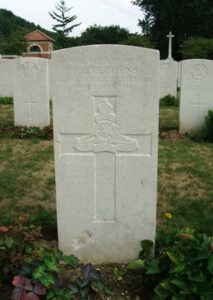
Joseph Longstaff Watson, Lieutenant, 16th Battalion, Canadian Infantry. Joseph was born at Banchory, Scotland on 4 May 1891, the youngest son of Charles France Watson and Florence Watson (nee Longstaff). His parents died when he was just 13, and Joseph came to live with his Aunt, Mrs. Owen, the wife of the Bishop of St. Davids, at Abergwili Palace. Joseph had emigrated to Canada prior to the war and worked as a Rancher prior to enlisting into the Canadian Expeditionary Force at Victoria, British Columbia, on 9 February 1915. He was then posted to the 30th Battalion, Canadian Infantry, as a Private, with the service number 77958, before being posted to the 16th Battalion (Manitoba), Canadian Infantry, which was attached to the 3rd Brigade, 1st Canadian Division. Joseph would have been in France by June 1915, and probably fought at Givenchy that month. In 1916, the 1st Canadian Division fought at Mount Sorrel, south of Ypres. Joseph was wounded here, suffering shrapnel in his buttock, and was treated at the 14th General Hospital Wimereux, before being sent back to Britain and admitted into the 1st Scottish General Hospital at Aberdeen. It was not until September that he had recovered enough to rejoin the Canadian Infantry Depot at Epsom, but was hospitalised again in April 1917, suffering from severe eczema to his face. On 17 April 1917 he was discharged from hospital and on 25 August 1917 rejoined his battalion on the Western Front after having been commissioned as Second Lieutenant. By now the 1st Canadian Division had taken part in the famous assault on Vimy Ridge and was in the midst of the Battle of Hill 70 when Joseph arrived. The Canadians then moved north to the Ypres Salient, to take part in the Second Battle of Passchendaele from 26 October onwards. Joseph was killed in action at Ypres on 8 November 1917. The 26-year-old was originally buried on the battlefield on Passchendaele Ridge, but after the war his grave was located and he was identified by his ID disc, before being re-interred in Tyne Cot Military Cemetery. His elder brother Robert also fell during the war. Joseph is not commemorated at St. David’s.
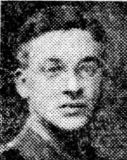
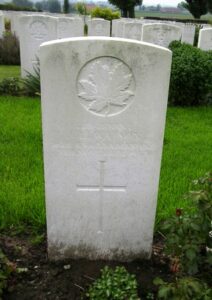
Robert Watson, Sergeant, 189, Australian Infantry. Robert was born at Appleby, Westmoreland in 1880, the elder of the three sons of Charles France Watson and Florence Watson (nee Longstaff). He was the nephew of Mrs. Owen, the wife of the Bishop of St. David’s, who lived at Abergwili Palace. Robert had served during the Boer War with the Royal Garrison Artillery, before emigrating to Australia, where he became a Medical Student. Robert enlisted at Sydney on 21 August 1914 into the newly formed 4th Battalion, Australian Imperial Force, which was part of the 1st Australian Brigade, 1st Australian Division. On 20 October 1914 the ‘Fighting Fourth’ embarked at Sydney aboard H.M.A.T. Euripides, and set sail for Egypt via Ceylon and the Suez Canal. The 1st Australian Division then set up camp in the shade of the Great Pyramids, at Mena Camp, on the outskirts of Cairo, where they trained hard over the coming months, readying for what they thought would be a move to France. However, early in 1915, it had been realised that a bold move was needed to try and break the stalemate that had developed in France, and so the War Office decided on seizing the Gallipoli Peninsula, the key to the Dardanelles Straits, in order to send a naval force to seize Constantinople, and bring Turkey out of the war. On 25 April 1915 the Fighting Fourth landed on the shores of Anzac Cove, as part of the second wave, and saw some terrible fighting over the coming weeks, while trying to break out of their beach-head. Robert was wounded soon after, and was evacuated by Hospital Ship to No. 5 Indian General Hospital at Alexandria, where he died of his wounds on 9 May 1915. The 35-year-old was buried in Alexandria (Chatby) Military Cemetery, Egypt. Robert is not commemorated locally.
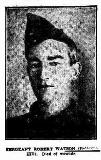
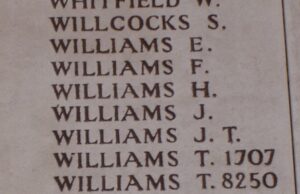
Hugh Williams, Private, 54151, Welsh Regiment. Hugh was the son of Evan and Ann Williams, of Maendewi Farm, St. David’s, and enlisted into the 13th Battalion, Welsh Regiment, which was the 2nd Rhondda Battalion. The Battalion trained at Rhyl before moving to Winchester in 1915, where it became part of 114 Brigade, 38th (Welsh) Division, and landed in France in December 1915, taking the line near Fleurbaix. In June 1916 the Division marched south to the Somme, where it took part in the capture of Mametz Wood between 7 and 12 July, before being sent to positions on the Canal Bank North of the City of Ypres. The Division remained at Ypres for the following twelve months, and here took part in the opening assault of the Battle of Passchendaele, when they captured Pilckem Ridge on 31 July 1917. Hugh was killed that day during the terrible fighting that day. He was 28 years old, and is commemorated on Panel 37 of the Ypres (Menin Gate) Memorial, Belgium.
Walter Kent Williams, MVO, Engineer Captain, Royal Navy. Walter was born at St. Davids on 24 October 1863, the son of William Philips Williams and Mary Williams (nee Kent). His father was a newspaper reporter, so the family regularly moved around the country. Walter was educated at Cardiff, and at the Royal Naval College at Devonport, and had been in the Royal Navy for 29 years prior to the war. At the outbreak of war he was posted to HMS Bulwark, a Formidable Class Battleship. Before the war, Formidable had been commanded by Captain Robert Falcon Scott. She joined the 5th Cruiser Squadron, and was stationed near Sheerness in November 1914, where she carried out patrols in the English Channel. On 26 November 1914 she was at anchor off Sheerness when she suddenly exploded, and sank with the loss of 736 men. Walter was killed aboard the Bulwark that day. He was 51 years old, and is remembered on the Portsmouth Naval Memorial, Hampshire. A subsequent investigation came to the conclusion that incorrectly stores cordite charges had overheated, and created a massive internal explosion that tore the ship apart. Witnesses reported that “a huge pillar of black cloud belched upwards… From the depths of this writhing column flames appeared running down to sea level. The appearance of this dreadful phenomenon was followed by a thunderous roar. Then came a series of lesser detonations, and finally one vast explosion that shook the Implacable from mastheads to keel.” Walter is not commemorated locally.
World War Two, 1939-1945
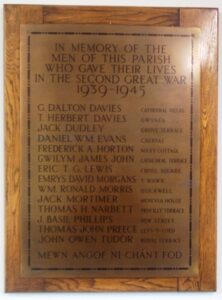
Hugh Barton-Smith, B.Sc., Flight Sergeant, 1312006, Royal Air Force Volunteer Reserve. Hugh was the son of Arthur Edward and Annie Emma Barton-Smith. Hugh had qualified as a Chemist, and had married May Ellen Hick, of St. Davids, prior to the war. He served with 15 Squadron, Royal Air Force, which was a heavy bomber squadron, operating Short Stirling’s from Cambridgeshire. On the night of 27 August 1942, Hugh took off in Stirling I, Serial W7624, bound for Kassel. The mission was a success, but Hugh’s aircraft was brought down by a German night-fighter on the return trip the following morning, 28 August 1942. Hugh was 26 years old, and is commemorated on the Runnymede Memorial, Surrey. One member of the crew was identified and buried, and the remainder of the crew buried in unmarked graves, as they could not be identified. Hugh is not commemorated at St. David’s.
George Dalton Davies, Sub-Lieutenant (A), Royal Navy. George was the son of George Beynon Davies and Edyth Davies, Of Cathedral Villas, St. David’s. He served in the Royal Navy at HMS Dipper, which was a Royal Naval Air Service Airfield, near Yeovil in Somerset. George died in a flying accident at Dipper on 20 June 1945. He was 22 years old, and was brought home for burial at St. David’s Parish Cemetery, where he lies today.
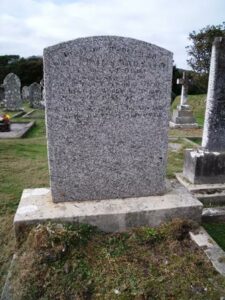
Thomas Herbert Davies, Pilot Officer (Navigator), 159934, Royal Air Force Volunteer Reserve. Thomas was the son of Herbert L. and Martha A. Davies, of Gwynfa, St. David’s, and served with 106 Squadron, RAF as a Navigator. This Squadron was a heavy bomber squadron, equipped with Avro Manchester’s and Avro Lancaster’s from 1942, based at RAF Syerston. On the night of 8 October 1943, a large force of over 500 bombers took off bound for Hannover. That night, the ancient city suffered its worst bombardment of the war, but the RAF attack had been pre-empted by the Luftwaffe, and German night fighters shot down 27 aircraft, including the Lancaster which Thomas was crewing. His Lancaster came down on the morning of 9 October 1943, killing all eight men aboard. Thomas was 34 years old, and is buried at Hanover War Cemetery, Germany, in Grave 3. D. 4.
John William Dudley (Jack), Able Seaman, Merchant Navy. Jack was born in Sale, Cheshire in 1906. He lived at Grove Terrace, St. Davids prior to the war, after having joined the Merchant Navy on 6 March 1925. By the outbreak of war Jack was serving aboard the Liverpool registered S.S. Kyleglen. On 15 December 1940, Kyleglen was in the North Atlantic, en-route from Oban to Nova Scotia, when she was torpedoed and sunk by the German submarine U-100, with the loss of all hands. Jack was 34 years old when he died that day, and is commemorated on the Tower Hill Memorial, London.
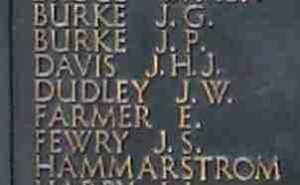
Daniel William Evans, Seaman, Merchant Navy. Daniel was born on 30 June 1908, the son of Robert Evans and Rachel Evans, of Ffynnon Faiddog, St Davids. He left home as a young man to enlist into the Merchant Navy, and married Lilian Louisa Taylor in London in 1938. Nothing further is known of Daniel, except that he died at sea on 10 May 1941, aged 32. The St. Davids war memorial states that he resided at Caerfat, St. David’s. He is not commemorated by the CWGC.
John Aidan Butler Finch, Sergeant, 1582444, Royal Air Force Volunteer Reserve. John was the son of the Revd. Laurence Finch and Gertrude Finch, and the nephew and ward of Phyllis S. R. Finch, of St. David’s. He served with 19 OTU, Royal Air Force, which was a training unit, based at RAF Kinloss. On 28 August 1944 John was flying aboard Armstrong Whitworth Whitley, Serial Z6739, when it disappeared with the loss of all her crew of six. John was 21 years old when he died that day, and is commemorated on the Runnymede Memorial, Surrey. John is not commemorated at St. David’s.
Willem Van Der Hoeven, Seaman, Dutch Merchant Navy. Willem was born at Heinenoord, Netherlands on 1 April 1887 and served in the Dutch Merchant Navy. Following the invasion of mainland Europe by the Germans in 1940 he escaped captivity and continued to serve at sea aboard the Dutch steamship Beemsterdijk. On 26 January 1941, Beemsterdijk was en-route from Greenock to Cardiff in ballast, when she struck a mine. The crew abandoned the stricken ship, and escaped in her lifeboats, but on the following morning, seeing her still afloat, returned aboard her to await rescue. Two days later, with still no sign of rescue, the crew relaunched their lifeboats and left the sinking ship, but were thrown into the water by its suction, which overturned the lifeboats. Willem was 54 years old when he drowned during the loss of his ship. His body later washed ashore near St. Davids, and he was buried in St. David’s Parish Cemetery. As he was not a local man, Willem is not commemorated on the St. Davids war memorial.
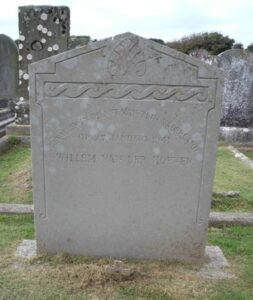
Frederick Augustus Horton, Second Engineer, Merchant Navy. Frederick was born at Aberarth in 1908, the son of Augustus Robert Horton and Agnes Anne Horton (nee Evans). He married Margaret Gwendolyne Phillips in 1930, and the couple resided at Mary Cottage, St. David’s. Frederick served with the Merchant Navy, aboard the S.S. Brockley Combe. He died at St Sampsons Harbour, Guernsey on 25 December 1945, aged 36. Frederick is not commemorated by the CWGC.
Gwilym James John, Petty Officer Telegraphist, D/JX 138284, Royal Navy. Gwilym was from Cathedral Terrace, St. David’s, and served in the Royal Navy at HMS Drake, the Royal Naval Barracks at Plymouth. Gwilym must have been serving aboard a vessel at the time of his death on 14 October 1942, but little else is known of him at present except that he is listed as Died on War Service. He is commemorated on Panel 68 of the Plymouth Naval Memorial, Devon.
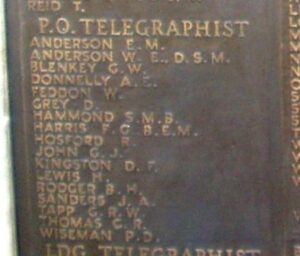
Eric Thomas Gibbon Lewis, Leading Airman, FAA/FX. 76789, Royal Navy. Eric was the son of Sidney Elvet Lewis and Martha Harries Lewis, of Aberystwyth, and lived at Cross Square, St. David’s, prior to the war. He served with 814 Squadron, Royal Naval Air Service 814 Squadron was first formed in 1938 with twelve Swordfish on board HMS Hermes, and war service included protection for convoys around South Africa, in Dakar and in the Far East, and in 1942, was based at HMS Lanka, the Royal Naval Base at Colombo. Eric was killed here on 6 June 1942. He was 24 years old, and is commemorated on Panel 2 of the Lee-On-Solent Memorial, Hampshire.
Emrys David Morgans, Chief Engineer Officer, Merchant Navy. Emrys was the Husband of Edna Margaret Morgans, of Y Wawr, St. David’s, and served in the Merchant Navy aboard the M.V. Conus, a London registered tanker. During the evening of 4 April 1941, the Conus, dispersed from convoy OB-304, was hit by one torpedo from U-97 and stopped southeast of Cape Farewell. The U-boat then fired its last two torpedoes at her, and Conus capsized and sank within ten minutes of the third torpedo hit. Emrys was one of 59 men aboard her who died. He was 41 years old, and is commemorated on Panel 31 of the Tower Hill Memorial, London. The photograph of Emrys is courtesy of Eluned Morgan MS.
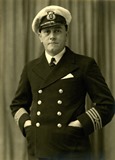
William Ronald Morris, Leading Seaman, P/JX 140427, Royal Navy. William was the son of Frederick and Phoebe Morris, of Quickwell, St. David’s. He served in the Royal Navy aboard H.M. Submarine Odin. She had been built at Chatham in 1928, and after the outbreak of war, moved to the Mediterranean. On 27 June 1940, Odin was surprised while on the surface charging her batteries, and sunk by the Italian destroyer Strale in the Gulf of Taranto, on 14 June 1940, with all hands. William’s date of death is given as 27 June 1940, so it is possible that he either survived the sinking, and died as a Prisoner of War, or that the CWGC show the wrong date. He was 23 years old, and is commemorated on Panel 38 of the Portsmouth Naval Memorial, Hampshire.
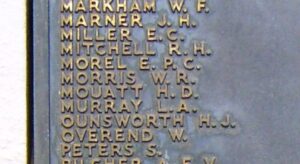
Robert John Mortimer, (Jack), Ordinary Seaman, Merchant Navy. Robert was the son of Sidney Wilfred and Lily M. Mortimer, of Menevia House, St. Davids, and was known locally as Jackie. Jackie’s father Sidney was a local personality, being the Coxswain of the St. David’s Lifeboat, and a holder of the King’s Medal. Jackie followed his father in working on the seas, joining the Merchant Navy, where he served aboard SS Ruperra, alongside the other local Man John Tudor Owen. Ruperra was a Cardiff registered cargo vessel. On 19 October 1940, Ruperra was en route from New York to Greenock and Leith in Convoy HX-79, carrying a cargo of steel billets, scrap iron and 20 Grumman Wildcat aircraft, when she was torpedoed by German submarine U-46 and sank with the loss of 30 men, including Robert. He was just 19 years old, and is commemorated on Panel 89 of the Tower Hill Memorial, London, alongside John Tudor. Many thanks to Richard Parr for the photo of the Mortimer family grave which helped me to identify Jackie.

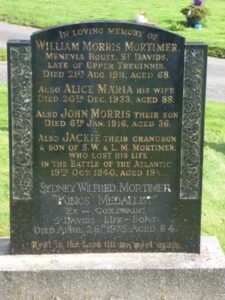
Thomas Henry Narbett, Leading Stoker, D/KX 83645, Royal Navy. Thomas lived at Priscilly Terrace, St. David’s, and served in the Royal Navy aboard HMS Penylan. Penylan was a Hunt Class Destroyer, and was newly launched and commissioned in August 1942, when she sailed to Scapa Flow, where she remained until the end of September 1940, after which she sailed to Portsmouth, where she joined the 1st Destroyer Flotilla on patrol in the English Channel. She was deployed on 1 December to escort convoy PW-257. The convoy was attacked by E-boats on 3 December, and Penylan was torpedoed and sunk five miles south of Start Point by the German E-boat S115. Thomas was one of fifty men aboard her that died that day, and he is commemorated on Panel 69 of the Plymouth Naval Memorial, Devon.
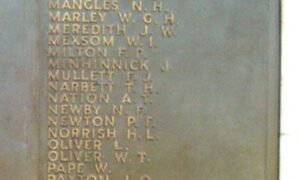
Joseph Basil Phillips, Gunner, 1710084, Royal Artillery. Joseph was the son of Andrew and Ann Phillips, and the husband of Lilian Phillips, of New Street, St. David’s. He served with 80 Heavy Anti Aircraft Regiment, Royal Artillery, which was in North Africa, attached to the 1st Army. Joseph was killed in North Africa during the fighting around Tripoli on 7 January 1943. He was 36 years old, and is commemorated on Face 7 of the Medjez-El-Bab Memorial, Tunisia.
Thomas John Preece, Carpenter, Merchant Navy. Thomas was the Husband of G. C. Preece, of Llys-y-Coed, St. David’s. He served in the Merchant Navy aboard the S.S. Ocean Crusader, which was a Liberty Ship, which was completed on 13 November 1942. She left New York for Avonmouth with a general cargo as part of the Liverpool bound Convoy HX-216 on 19 November 1942, but a sometime during the crossing, she fell behind the main convoy, as she fought her way through heavy weather, possibly to aid another vessel. On 26 November 1942, North-East of Newfoundland, Ocean Crusader was intercepted by U-262, and was torpedoed and sunk with the loss of all hands. Thomas was 34 years old, and is commemorated on Panel 75 of the Tower Hill Memorial, London.
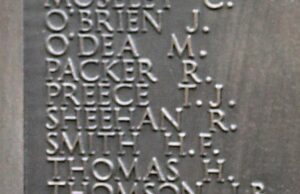
John Owen Tudor, Second Engineer Officer, Merchant Navy. John was the son of Capt. Thomas Tudor and Mary Tudor, and the husband of Nellie Tudor, of Royal Terrace, St. David’s. He served in the Merchant Navy aboard SS Ruperra, a Cardiff registered cargo vessel. On 19 October 1940, she was en route from New York to Greenock and Leith, in Convoy HX-79, carrying a cargo of steel billets, scrap iron and 20 Grumman Wildcat aircraft, when she was torpedoed by the German submarine U-46 and sank with the loss of 30 men, including John. He was 52 years old, and is commemorated on Panel 89 of the Tower Hill Memorial, London.
